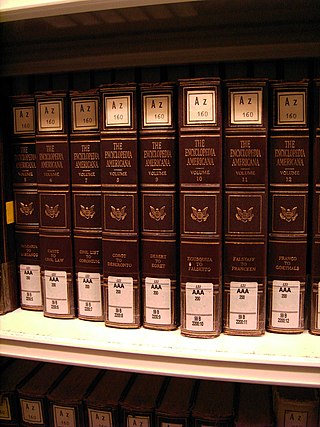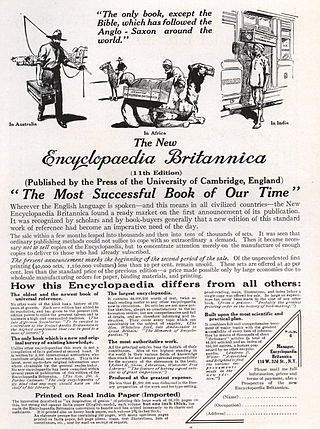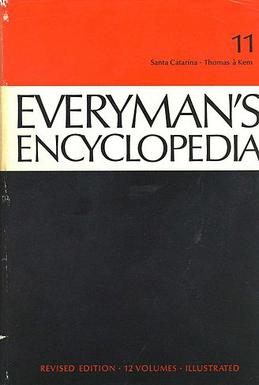Related Research Articles

An encyclopedia or encyclopædia is a reference work or compendium providing summaries of knowledge, either general or special, to a particular field or discipline. Encyclopedias are divided into articles or entries that are arranged alphabetically by article name or by thematic categories, or else are hyperlinked and searchable. Encyclopedia entries are longer and more detailed than those in most dictionaries. Generally speaking, encyclopedia articles focus on factual information concerning the subject named in the article's title; this is unlike dictionary entries, which focus on linguistic information about words, such as their etymology, meaning, pronunciation, use, and grammatical forms.

The Encyclopædia Britannica is a general knowledge English-language encyclopaedia. It has been published by Encyclopædia Britannica, Inc. since 1768, although the company has changed ownership seven times. The encyclopaedia is maintained by about 100 full-time editors and more than 4,000 contributors. The 2010 version of the 15th edition, which spans 32 volumes and 32,640 pages, was the last printed edition. Since 2016, it has been published exclusively as an online encyclopaedia.

Encyclopedia Americana is a general encyclopedia written in American English. It was the first general encyclopedia of any magnitude to be published in North America. With Collier's Encyclopedia and Encyclopædia Britannica, Encyclopedia Americana became one of the three major and large English-language general encyclopedias; the three were sometimes collectively called "the ABCs of encyclopedias". Following the acquisition of Grolier in 2000, the encyclopedia has been produced by Scholastic.
The World Book Encyclopedia is an American encyclopedia. World Book was first published in 1917. Since 1925, a new edition of the encyclopedia has been published annually. Although published online in digital form for a number of years, World Book is currently the only American encyclopedia which also still provides a print edition. The encyclopedia is designed to cover major areas of knowledge uniformly, but it shows particular strength in scientific, technical, historical and medical subjects.

The Canadian Encyclopedia is the national encyclopedia of Canada, published online by the Toronto-based historical organization Historica Canada, with the support of the federal Department of Canadian Heritage.

Chambers's Encyclopaedia was founded in 1859 by William and Robert Chambers of Edinburgh and became one of the most important English language encyclopaedias of the 19th and 20th centuries, developing a reputation for accuracy and scholarliness that was reflected in other works produced by the Chambers publishing company. The encyclopaedia is no longer produced. A selection of illustrations and woodblocks used to produce the first two editions of the encyclopaedia can be seen on a digital resource hosted on the National Museums Scotland website.

Collier's Encyclopedia is a discontinued general encyclopedia first published in 1949 by P. F. Collier and Son in the United States. With Encyclopedia Americana and Encyclopædia Britannica, Collier's Encyclopedia became one of the three major English-language general encyclopedias. The three were sometimes collectively called "the ABCs". In 1998, Microsoft acquired the right to use Collier's Encyclopedia content from Atlas Editions, which had by then absorbed Collier Newfield. Microsoft incorporated Collier's Encyclopedia's content into its Encarta digital multimedia encyclopedia, which it marketed until 2009.

Grolier was one of the largest American publishers of general encyclopedias, including The Book of Knowledge (1910), The New Book of Knowledge (1966), The New Book of Popular Science (1972), Encyclopedia Americana (1945), Academic American Encyclopedia (1980), and numerous incarnations of a CD-ROM encyclopedia (1986–2003).
The New Book of Knowledge is an encyclopedia published by Grolier USA.

The Encyclopædia Britannica has been published continuously since 1768, appearing in fifteen official editions. Several editions have been amended with multi-volume "supplements", consisted of previous editions with added supplements or gone drastic re-organizations (15th). In recent years, digital versions of the Britannica have been developed, both online and on optical media. Since the early 1930s, the Britannica has developed several "spin-off" products to leverage its reputation as a reliable reference work and educational tool.
Academic American Encyclopedia is a 21-volume general English-language encyclopedia published in 1980. It was first produced by Arête Publishing, the American subsidiary of the Dutch publishing company VNU.

Everyman's Encyclopaedia is an encyclopedia published by Joseph Dent from 1913 as part of the Everyman's Library.

MicrosoftEncarta is a discontinued digital multimedia encyclopedia published by Microsoft from 1993 to 2009. Originally sold on CD-ROM or DVD, it was also available online via annual subscription, although later articles could also be viewed for free online with advertisements. By 2008, the complete English version, Encarta Premium, consisted of more than 62,000 articles, numerous photos and illustrations, music clips, videos, interactive content, timelines, maps, atlases and homework tools.
The Lincoln Library of Essential Information was originally published as a one-volume general-reference work, in 1924. In later years, it was published in two- and three-volume editions, and the title was changed.
This is intended to be as comprehensive a list as possible of encyclopedias and encyclopedic/biographical dictionaries ever published in any language. The list will not include reprinted editions but it is intended to list an alphabetical bibliography by theme and language to anything which resembles an A–Z encyclopedia or encyclopedic dictionary, both print and online. Entries are in the English language unless specifically stated as otherwise. Several entries may overlap and be listed under several different topics. For a simple list without bibliographic information see Lists of encyclopedias.
The New Standard Encyclopedia was the most common name for an encyclopedia that ran from 1910 to the mid-1960s.
The Human Interest Library was a children's encyclopedia published from the 1910s to at least the mid-1960s.
Our Wonder World was a children's encyclopedia published from the 1910s to the mid-1960s, under a variety of names.
The Volume Library was a one volume general encyclopedic reference work that was published from 1911 to 1985. It remained as a two or three volume reference work until at least 2004.
Collins Concise Encyclopedia was the most common name for an encyclopedia that was published in various formats and names from 1921 until at least the early 1990s.
References
- 1 2 Encyclopædia Britannica, 1988.
- ↑ Kenneth F. Kister Best Encyclopedias Phoenix, AZ; Orynx Press 1986 p.53
- ↑ S. Padraig Walsh Anglo-American General Encyclopedias 1704–1967 New York: R. R. Baker and Company, 1968 pp. 32–3, Kister 1986 p.53 The sources disagree about when Compton's was bought by Encyclopædia Britannica, Inc. Walsh says 1962, Kister says 1961
- ↑ Kister 1986 pp.53-4
- ↑ Kister 1986 p.53
- ↑ Kister 1986 p.55
- ↑ Kister pp.54, 56-7. Kister notes that the set incorrectly dates Roe v. Wade to 1971, rather than 1973
- ↑ Kister 1986 p.54
- ↑ Kenneth F. Kister Best Encyclopedias Phoenix, AZ; Orynx Press, Second Edition, 1994 p.61
- ↑ Kister 1994 pp.61-2
- ↑ Kister 1994 pp.62, 64
- ↑ Kister 1994 pp.63-4
- ↑ Kister 1994 p.67
- ↑ Kister 1994 p.65
- ↑ Kister 1994 pp.63, 66
- 1 2 3 4 5 6 Kister's Best Encyclopedias,1994
- ↑ "Compton's Encyclopedia Returns to Britannica" Archived 2008-06-11 at the Wayback Machine , news release, Encyclopædia Britannica, March 20, 2002
- ↑ Library of Congress catalog entry